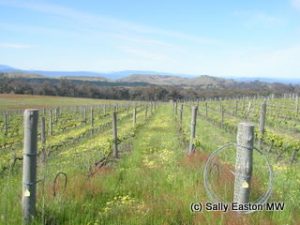Savaterre

Low-slung Savaterre vines
The owner and winemaker of Savaterre, Keppell Smith, set up shop in 1996, spitting distance across the road from famed Beechworth producer Giaconda. This migrant from the financial world said “all I want is a wine with personality” and this ‘simple’ wish had seen him search high and low across Australia’s wine regions for the perfect spot he says he’s found on the south facing slopes of the Beechworth hills, with their decomposing granite and clay soils. Of his now home-turf Beechworth’s wines he said “I couldn’t understand why one of the best wineries – Giaconda – was here. His was the first [Australian] wine with a European bent that I’d tasted – there was so much perfume, elegance, structure.”
So Smith planted chardonnay and pinot noir at around 460m above sea level, “six rows alternately because I didn’t know which would do best. But all do well” he said. He added shiraz to the vineyard in 2005, bringing his plantings to five hectares. The vines are trained low on cordons, because, Smith said “the humidity here in summer is very low, and there is twice the humidity closer to ground” which he says helps keep the aromas in the fruit. The vines are planted at a dense 8,000 vines per hectare, which he said “is important for pinot noir here, you get the best intensity, structure and aroma from close planting.”
In 2010 work was well underway on an imposing new winery, with cement fermentation vats. “I was using stainless steel” he said, “but it let out too much heat, too fast.” In the winery Smith says he’s just babysitting “I leave it alone, no yeast, no bacteria, I add sulphur, occasionally a little acid.” But there is no complacency in this minimal approach. “The attention to detail” is crucial, he said “every 1% you muck up, it’s cumulative.”
He does leave wines on the lees for a long time, about a year, “not stirred or anything” to add a creaminess to the texture. On the reds, he said “lees really help the wood marry with the wine. It’s the gravy between the peas and the roast, the juice that brings it all together.”
His first vintage was in 2000, just two barrels of chardonnay. It must have been an auspicious beginning, because, just a decade later, in the 2010 issue of Langton’s classification, the Savaterre chardonnay jumped into the distinguished category of emerging classics.
As to the Savaterre name, it is the name of Smith’s father’s property in Chesapeake Bay in Virginia, USA – “a piece of low-lying swamp land”, he said. There is no similarity.
Tasting notes, in situ, October 2010
Savaterre, Chardonnay 2008
50% new French oak. 13.5%
Deep lemon colour. Creamy, leesy/yeast, hint buttery – not a fruit-based aroma, though some dry lemon toast notes on the palate, smooth, linear texture. Sweet-savoury yeast flavour going on in a serious and sophisticated, multi-layered wine.
Savaterre, Pinot noir 2008
13.5%. Pale cherry colour. Smoked cherry, savoury, smooth texture, dry spice and dry-sweet texture, savoury-sweet combo, delightful texture. Dark cherry fruit emerging, dry baked and layered. Texture is fine and refined.
My research visit to Australia in October 2010 was sponsored by Wine Australia.



